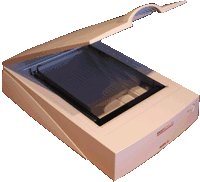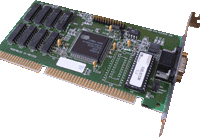| Problem 2: Übersicht über einige RAM-Module |
Eine kleine Orientierungshilfe beim Erweitern Ihres PC mit RAM-Modulen bietet Ihnen folgende Übersicht:
Name |
Bezeichnung |
I/O-Takt |
Bandbreite pro Modul |
Bemerkung |
PC100 |
PC100 |
100 MHz |
veralteter SD-RAM |
|
PC133 |
PC133 |
133 MHz |
1 GByte |
veralteter SD-RAM (168-poliges DIMM-Modul) |
PC2100 |
DDR266 |
133 MHz |
2,1 GByte |
erste DDR-RAM-Version (184-polig) |
PC3200 |
DDR400 |
200 MHz |
3,2 GByte |
RAM für Pentium 4 und Athlon64 |
PC3500 |
DDR433 |
217 MHz |
3,5 GByte |
nicht JEDEC-Spezifiziert |
PC2-3200 |
DDR2-400 |
200 MHz |
3,2 GByte |
DDR2 RAM (240-polig) |
PC2-4200 |
DDR2-533 |
266 MHz |
4,2 GByte |
|
PC2-6400 |
DDR2-800 |
400 MHz |
6,4 GByte |
|
PC3-6400 |
DDR3-800 |
400 MHz |
6,4 GByte |
DDR3 RAM (240-ig polig) |
PC3-8500 |
DDR3-1066 |
533 MHz |
8,5 GByte |
|
PC3-10600 |
DDR3-1333 |
667 MHz |
10,6 GByte |
|
PC3-12800 |
DDR3-1600 |
800 MHz |
12,8 GByte |
|
PC3-17000 |
DDR3-2133 |
1066 MHz |
17,066 GByte |
|
PC4-1600 |
DDR4-1600 |
800 MHz |
12,8 GByte |
DDR4 RAM (288 Pins) |
PC4-2400 |
DDR4-2400 |
1200 MHz |
19,2 GByte |
|
Kenngrößen:
- Speicherkapazität: in MB (Megabyte) oder GB (Gigabyte)
- Bauform:
- SIMM (Single Inline Memory Module): 30 bzw. 72 Kontakte in einer Reihe, in älteren PCs.
- DIMM (Dual Inline Memory Module): 168, 184 bzw. 240 Kontakte in zwei Reihen, gängiger Standard.
- RIMM (Rambus Inline Memory Module): 184 Kontakte auf beiden Seiten, kaum vorhanden.
- SO-DIMM (Small Outline): 144 bzw. 200 Kontakte, für Notebooks.
- SO-RIMM (Small Outline): 160 Kontakte, Rambus-Version für Notebooks, kaum vorhanden
- Speichertyp:
- D-RAM - begrenzte Speichergröße von 16 bis 64 MB, nur in älteren PCs mit 30 bzw. 72 Pins
- SD-RAM - in alten Pentium-III-PCs mit 168 Pins, maximale Taktfrequenz 166 MHz
- DDR - pro Bustakt zwei Datenraten, d.h. doppelte Geschwindigkeit, 184 Pins.
- DDR2 - zwei Speicherzugriffe pro Takt, 240 Anschlusspins, etwas größer aber stromsparender.
- DDR3-SDRAM (Double Data Rate 3 SDRAM) mit 1,5V und 240 Pins
- DDR4-SDRAM (Double Data Rate 4 SDRAM) mit 1,2V und 288 Pins
- Rambus/DRD-RAM
- Taktfrequenz: in Megahertz (MHz), also z.B. PC100, DDR266, DDR2-400.
- CL-Wert (CAS Latency): Verzögerung während Datenübertragung, Werte von 2 bis 4 sind üblich (niedriger CL-Wert bedeutet schnelle Verarbeitung). Bei mehreren RAM-Bausteinen sollten alle denselben CL-Wert aufweisen.
- Datendurchsatz: wird meist in GByte pro Sek. angegeben, z.B. PC2700 mit 2,7 GByte/s
- buffered / unbuffered, registered / unregistered: Speicher mit oder ohne zusätzliche Zwischenspeicher (Puffer oder Register).
Ausführliche Informationen zu dieser stets sich weiter entwickelnden Problematik findet man überall im Internet.


